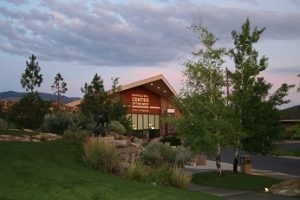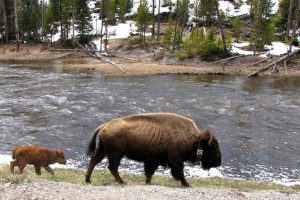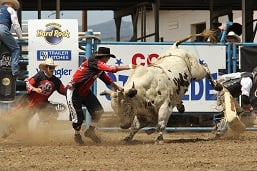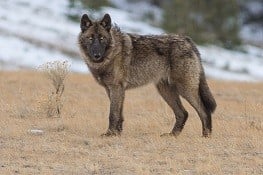
These Things Might Have Knocked Buffalo Bill Cody Off His Steed…Figuratively, of Course
CODY, Wyo., Aug. 25, 2017 – This year is the 100th anniversary of the death of Buffalo Bill Cody, a man who spent his life surprising those around him. He surprised a railroad with his hunting prowess, a queen with his charm, women and American Indians with his new-fashioned sense of fairness and tolerance and an entire town with his visionary restlessness. He was the quintessential self-reliant frontiersman, a pragmatist who was not easily surprised.
A lot can happen in a century, though, and some occurrences in his namesake town of Cody, Wyoming during the last century might just knock Buffalo Bill off his horse, figuratively speaking.
Here are some of them:

The Buffalo Bill Center of the West is a world-class facility.
The museum that bears his name is a world-class destination.
Just weeks after his death, Cody’s friends formed the Buffalo Bill Memorial Association, which has morphed into the Buffalo Bill Center of the West, a complex of five museums. Recently named the top Western Museum in the country by True West Magazine, museums include Buffalo Bill Museum, Draper Natural History Museum, Plains Indian Museum, Whitney Western Art Museum and Cody Firearms Museum. Visitors come from throughout the world to wander the expansive galleries and rotating exhibits and witness cultural and historic events like the annual Plains Indian Powwow and Rendezvous Royale, a celebration of Western art.

The American Bison has made a comeback.
The American Bison was rescued from extinction
Buffalo Bill and other 1800s hunters dramatically depleted the free-roaming herds of bison. In one 18-month period in the late 1860s, Cody killed more than 4,000 bison to feed railroad workers. By 1901, there were only 25 bison in nearby Yellowstone National Park. Cody might be surprised that painstaking conservation efforts in Yellowstone and elsewhere were able to repopulate the species. Today, there are 4,000 bison in Yellowstone Country.Wolves went and came.Once abundant, the numbers of gray wolves had been steadily decimated by ranchers, hunters and Yellowstone National Park managers, and nine years after Buffalo Bill’s death, they were completely gone. Due to the relentless dedication of biologists, conservationist and others, however, wolves were returned to the park in 1995.
The newspaper he founded is still tops.
Buffalo Bill Cody and his associate John Peake established the Cody Enterprise in 1899, and the continuously operated semi-weekly newspaper has won many awards for journalistic excellence throughout its The American Bison has made a comeback. history.
We’re still talking about his grave.
Buffalo Bill wanted to be buried on Cody’s Spirit Mountain, but sad circumstances led to a Denver funeral and burial in a suburban monument that was recently named Colorado’s worst tourist trap. But many Cody residents to this day claim that his body is buried in an unmarked grave atop the Cody mountain. Here’s the story: His beleaguered widow made a deal with publicity-hungry politicians and the publisher of The Denver Post, who offered cash to keep his body in Colorado. Outraged, heartbroken friends traveled covertly to Denver to switch Buffalo Bill’s corpse with that of a lookalike ranch hand and quietly buried his body on top of the mountain that overlooks the town he built. Or so the story goes.
 Cody is the “Rodeo Capital of the World.”He started it, and rodeo is still a thing.
Cody is the “Rodeo Capital of the World.”He started it, and rodeo is still a thing.
Buffalo Bill’s very first Wild West Show, which he first staged in North Platte, Neb. in 1882, helped inspire professional rodeo as it is today. When the Wild West Show went on tour, the combination of skill and showmanship prompted audiences to romanticize and novelists to popularize life in the “Wild West.” Today, equestrians, cowboys and clowns perform their tricks and showcase their talents at the Cody Nite Rodeo, the longest running summer-season nightly rodeo in the U.S. This was the 98th year of the Cody Stampede, multiple days of rodeos during the July 4 holiday.
A dark spot in Cody’s history has prompted ongoing discussions of racial tolerance.
Buffalo Bill was ahead of his time in many ways, including his tolerant and fair treatment of American Indians and women. It might surprise him, then, that the U.S. government chose a bleak, windswept mountain just outside of Cody to imprison 14,000 Japanese-American citizens during World War II. The award-winning Heart Mountain WW II Interpretive Center reminds visitors of the heartbreaking challenges faced by incarcerees while urging them to ask themselves the question, “could this happen again?”
Cody has grown, but not that much.
There are now nearly 10,000 full-time residents of Cody. That’s downright urban compared to the town’s population of about 1,200 around the time of his death, but it is still a small town by most standards.
###
Yellowstone Country is comprised of the towns of Cody, Powell and Meeteetse as well as the valley east of Yellowstone National
The area of Park County is called “Buffalo Bill’s Cody/Yellowstone Country” because it was the playground of Buffalo Bill Cody himself. Buffalo Bill founded the town of Cody in 1896, and the entire region was driven and is still heavily influenced by the vision of the Colonel. Today its broad streets, world-class museum Buffalo Bill Center of the West and thriving western culture host nearly 1 million visitors annually.
Related hashtags: #YellowstoneCountry #CodyWyoming #CenteroftheWest #BuffaloBill #Yellowstone #Wyoming
Media contact:
Mesereau Travel Public Relations


